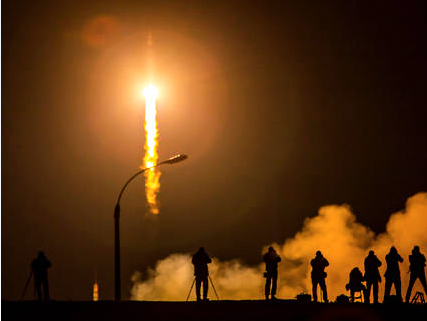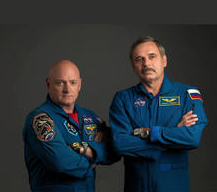
Media photograph the Soyuz TMA-16M spacecraft as it launches to the International Space Station with Expedition 43 NASA astronaut Scott Kelly, Russian cosmonauts Mikhail Kornienko and Gennady Padalka of the Russian Federal Space Agency (Roscosmos) onboard at 3:42 p.m. EDT Friday, March 27, 2015 (March 28 Kazakh time) from the Baikonur Cosmodrome in Kazakhstan. As the one-year crew, Kelly and Kornienko will return to Earth on Soyuz TMA-18M in March 2016. Image Credit: NASA/Bill Ingalls
[SatNews] Two humans said farewell to Earth for nearly 12 months.
At 3:42 p.m. EDT Friday, March 27, 2015 (March 28 Kazakh time) from the Baikonur Cosmodrome in Kazakhstan NASA astronaut Scott Kelly and Russian Cosmonaut Mikhail Kornienko were launched to the International Space Station, beginning a one-year mission in space, testing the limits of human research, space exploration and the human spirit. The one-year crew, Kelly and Kornienko will return to Earth on Soyuz TMA-18M in March 2016.
Most expeditions to the space station last four to six months. By doubling the length of this mission, researchers hope to better understand how the human body reacts and adapts to long-duration spaceflight. This knowledge is critical as NASA looks toward human journeys deeper into the solar system, including to and from Mars, which could last 500 days or longer. It also carries potential benefits for humans here on Earth, from helping patients recover from long periods of bed rest to improving monitoring for people whose bodies are unable to fight infections.
Long exposure to a zero-gravity environment can affect the human body in multiple ways. Some physical symptoms can include changes to the eyes, muscle atrophy and bone loss. Human psychology is also an important area of study, as the effects of living in isolated and small spaces will be important to understand ahead of future human missions to Mars. Research collected from the one-year mission can help NASA and the international partners reduce risks and better understand how to ensure astronauts will thrive on longer missions.
There are seven key elements of research on the one-year mission. Functional studies will examine crew member performance during and after the 12-month span. Behavioral studies will monitor sleep patterns and exercise routines. Visual impairment will be studied by measuring changes in pressure inside the human skull. Metabolic investigations will examine the immune system and effects of stress. Physical performance will be monitored through exercise examinations. Researchers will also monitor microbial changes in the crew, as well as the human factors associated with how the crew interacts aboard the station.

NASA astronaut Scott Kelly (left), Expedition 43/44 flight engineer and Expedition 45/46 commander; and Russian cosmonaut Mikhail Kornienko, Expedition 43-46 flight engineer, take a break from training at NASA's Johnson Space Center to pose for a portrait. Image Credit: NASA/Bill Stafford
While Scott Kelly is in space, his identical twin brother, retired NASA astronaut Mark Kelly, will participate in a number of comparative genetic studies. Some of these experiments will include the collection of blood samples as well as psychological and physical tests. These tests will track any degeneration or evolution that occurs in the human body from extended exposure to a zero-gravity environment. The new twin studies are a multi-faceted national cooperation between universities, corporations and government laboratory expertise.
All research gathered from both the American and Russian crew members will be shared between the countries, an important step in reducing cost and improving efficiency for all future space station research.
A number of spaceflight endurance records will be broken during the one-year mission, including the most cumulative time in space for any U.S. astronaut. Kelly and will spend 342 days off the planet resulting in a total of 522 days in space, allowing him to surpass current U.S. record holder Mike Fincke’s mark of 382 days. The current record for the longest single mission aboard the space station set by NASA astronaut Michael Lopez-Alegria and Russian cosmonaut Mikhail Tyurin will also be broken. Russian cosmonaut Gennady Padalka will launch with Kelly and Kornienko to remain aboard for six months and will become the new record holder for most cumulative time spent in space by any human.
The one-year crew mission is the latest step in the International Space Station’s role as a platform for preparing humanity for exploration into deeper space. With the collaborative efforts of the international crew and research teams, the world can watch and benefit from findings that are pushing the boundaries of exploration while contributing to human health.

